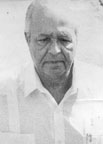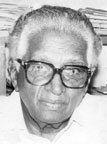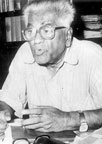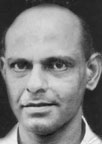The predicament of conventional Leftist parties in Sri Lanka
by W.T.A. Leslie FERNANDO
It was the conventional Left parties, that awakened people,
introduced socialism to our country and inspired masses to fight against
the reactionary forces. They were the first to agitate for full
independence which we enjoy today. They also won so many rights for
workers by their trade union activities. In the 1953 Hartal they were
able to tame the mighty UNP and get relief to people. The Hartal also
paved way for the 1956 revolution.
 |
|
Philip Gunawardena |
 |
|
Dr. S. A. Wickremasinghe |
 |
|
Leslie Gunawardena |
 |
|
Pieter Keuneman |
 |
|
J.C.T. Kotelawala |
 |
|
B.J. Fernando |
 |
|
Dr. Colvin R. de Silva |
 |
|
Doric de Souza |
 |
|
Dr. N.M. Perera |
With such a heroic past the conventional Left parties had become only
a shadow of their former glory. They had become a shell of their old
selves and had allied with foreign funded NGOs and Church sectors. The
LSSP and the CP had lost their popular support and the NLSSP that never
had a following were derided as "Three-wheeler parties" (Dr. Susantha
Goonatilaka; Recolonisation-Foreign Funded NGOs in Sri Lanka (2006) -
Page 273). The MEP too could exert its influence only in the
Kelanivalley. Why the conventional Left parties had to undergo such a
plight?
The LSSP which was inaugurated on December 18, 1935 was the first
Leftist party in Sri Lanka. The architect of the LSSP, Philip
Gunawardena, while he was studying in USA from 1922 to 1928 came under
the influence of Prof. Scot Nearing, the Lecturer in political theory
and became a socialist. When Philip came to England later, he found that
the criticisms made by Leon Trotsky on Soviet Communism were valid and
he too became a trotskyite. Dr. N.M. Perera, Dr. Colvin R. de Silva,
Leslie Gunawardena, B.J. Fernando and Vernon Gunasekera who were
studying in London at that time became Trotskyites following the
footsteps of Philip Gunawardena.
Philip set up the LSSP in Sri Lanka as a popular mass party with two
pronged objectives of obtaining full independence and establishing a
socialist society. He avoided controversial issues lime Trotskyism and
Stalinism. Like his old friend in Madison, USA Jayaprakash Narayan who
set up the Congress Socialist Party in India that had accommodated
everyone from Marxist revolutionaries to radical Ghandians, Philip also
formed the LSSP as a broadbased non-doctrinated democratic organisation.
In the general election 1936, held few months after the formation of
the LSSP, Philip won Avissawella and NM the Ruvanwella and entered the
State Council. The magnificent role of the duo, Philip and NM in the
State Council made the LSSP popular in the country in no time. Although
Philip and NM were Trotskyites they did not follow Trotskyism to the
letter. They tried to adopt Marxism to suit the conditions in Sri Lanka.
In 1939 when Stalin in Russia entered into a No-War Pact with Hitler
of Germany, the LSSP adopted a resolution condemning the Third
International led by Russia. The five members led by Dr. S.A.
Wickremasinghe who oppossed the resolution were expelled from the party.
They formed the Socialist Circle and later that became the Communist
Party. This was the first split in the LSSP.
The turmoil that caused the worst damage to the LSSP occurred when
the leaders of the proscribed LSSP who broke out of jail and were in
hiding in India. Till the LSSP was proscribed, the brains and energy
behind the LSSP was Philip Gunawardena. When the LSSP was proscribed,
the brains and energy behind the LSSP was Philip Gunawardena. When the
LSSP leaders were taken into custody during the World War II, Doric de
Souza got into the place of Philip and became its theoretician.
In 1942, when the first rank leaders of the LSSP were still in India,
Doric wanted to fill the vacancies of the party committee with
undergraduates. He named it as Bolshevecisation of the party. This move
was vehemently oppossed by the founder members of the LSSP like Robert
Gunawardena, Susan de Silva and the trade unions. When the news reached
the leaders in India like Philip, NM and Colvin, all of them condemned
the move of Doric as "Petty bourgeoise intellectuals who have turned
LSSP into a narrow conspiratorial sect cut off from the masses".
Accordingly Dr. Colvin R. de Silva issued a statement on behalf of
LSSP in India, "The party cannot be restored to health, unity and
effectiveness unless this faction is smashed". In response the group
around Doric formed the Bolshevic Leninist Party. The LSSP leaders in
India, in a counter move instructed the party cadres to expel the
Bolshevic group and appoint another committee. This could not be
effected as the LSSP was a proscribed organisation in Sri Lanka.
As a result the Bolshevics remained in control of the LSSP in Sri
Lanka. In the meantime there was a split among the LSSP leaders in India
into two groups Philip-NM group and Colvin-Leslie group as to how to
organise a revolution in India. The Bolshevics in Sri Lanka sided with
Colvin-Leslie group so that they could continue at the helm of the
party.
When Philip and NM came out of prison in 1945, the party was
controlled by the Bolshevics. It had assumed the name Sri Lankan section
of the Bolshevic Leninist Party of India. Philip and NM did not join it.
They went in search of party cadres and reconstituted the LSSP.
Thereupon the BLPI expelled Philip and NM form the party. However the
LSSP became stronger than the BLPI.
The lawyers and the University lecturers were found at the helm of
the BLPI. Philip accused them as an elitist petty-bourgeoise group
engaged in theoretical hair-splitting debates and branded them as 'Parlour
Bolshevics and arm-chair revolutionaries.' In the 1947 Parliamentary
elections, the LSSP and the BLPI contested separately but there was
no-contest pact between the two.
In 1950 when the LSSP and the Bolshevic Samasamaja Party merged,
Philip and his followers left the LSSP and formed the VLSSP. Although NM
became the leader of the merged party which was branded as the NLSSP, he
came under the influence of ardent Trotskyites like Colvin, Leslie and
Doric.
Philip Gunawardena was a practical politician. Even when he was a
Trotskyite he tried to form a government of progressives in 1947 under
S.W.R.D. Bandaranaike violating a cardinal principle of Trotskyism of
forming any form of coaltion with bourgeoise. Later Philip realised that
Trotskyism was a dead force and sought a coalition of all progressives
gainst the UNP.
There is a view that forming coalition governments have led to the
downfall of Left parties. This is not correct. The role of the two VLSSP
Ministers Philip Gunawardena and William de Silva in the 1956-59 MEP
regime not only made the VLSSP popular among the masses but also
enhanced the prestige of the Leftists. It is said that the followers of
NM were keen to make the LSSP join the SLFP government in 1964 resulting
in the break of the ULF, because they expected NM to perform better than
even what Philip achieved in the 1956-59 government. It is true that the
Leftist Ministers in like NM, Colvin, Leslie and Pieter Keuneman could
not achieve much in the 1970-77 Coalition. But that is a different
story.
One of the main reasons for the setback of the conventional Left
parties were the wrong decisions they have taken at crucial times. In
the 1960 March general election the MEP won 10 seats and came second in
about 15 electorates. In July 1960 election instead of contesting alone
if the MEP had entered into a no-contest pact with the SLFP like the
LSSP and the CP, the SLFP could not have won 75 seats and Leftists would
have been a powerful force in the government. Similarly in 1964 the ULF
was gaining momentum in the country. If the LSSP had not entered into a
coalition with the SLFP resulting in the break of the ULF, the ULF would
have achieved power in 1965 general election or in a subsequent
election.
It is said that It was the policies of Doric de Souza that led to the
debacle of the LSSP, the leading Leftist party in Sri Lanka. In this
connection Susan de Silva, one of the founder members of the LSSP has
released a booklet in 1959 titled 'The Wrecking of the LSSP!' In that
there are some insinuations to the effect that Doric de Souza entering
the LSSP was a Catholic plot.
In that book Susn de Silva identifies Doric de Souza and an ardent
Catholic and daily communicant. It is also alleged that another ardent
Catholic and CID officer Algie Perera who went to India on the trail of
the LSSP escapees from the prison was a close friend of Doric. It is
also highlighted when Doric and Karalasingham were arrested in India,
Doric was fined Rs. 300 and let go whereas Karalasingham was brought to
Sri Lanka under Police escort and detained.
Doric joined the LSSP at the time when the Catholic Church initiated
the 'Social Justice' movement to counteract Marxist parties. The 1962
abortive coup was led mainly by the Catholic high rankers in the forces.
Doric in the Senate emphasised the position taken up by the LSSP that
the SLFP government had planned the coup to arrest the Leftist leaders
and the officers has directed it against the government. Although there
may be some reasons to suspect, it is far-fetched to arrive that Doric
Souza joining the LSSP was a catholic conspiracy.
There is also a view that Trotkyism was a counter-revolutionary
movement. It is so emphasised by N. Shanmugathasan in his book 'A short
History of Left Movement in Ceylon'. Prof. Y. Ranjith Amarasinghe
maintains that this assumption is untenable. Although the headquarters
of Trotskyism is found in Paris, it is more prevalent among the
intellectuals in USA. The NGOs were initiated to prevent the spread of
Communism and Mrs. Kusala Abhayawardena a LSSP MP was a leader of SCI, a
famous NGO. Even today some leading Trotskytes are found close to NGOs
and church sectors.
Nevertheless these are later developments. The criticisms of Trotsky
about the autocratic rule of Stalin at the time in Russia were valid.
Although some forecasts of Trotsky did not come true it could not be
called that Trotskyism as a whole was counter-revolutionary.
The conventional Left parties never had an islandwide appeal.
Their power was confined basically to Western and Southern provinces.
There too they were strong in areas where workers lived. They were
powerful in other areas like the Kelani Valley, the domain of Philip
Gunawardena, Ambalangoda-Balapitiya, the native place of Dr. Colvin R.
de Silva and in the Matara district where Dr. S. A. Wickremasinghe was
able to command influence. They also wielded some power in the
Sabaragamuwa provinces where the Suriyamal movement had prepared the
ground for it.
The Left parties had some influence in Catholic areas around Negombo
and in Kalutara, Moratuwa and Panadura. In Kalutara, Moratuwa and
Panadura the Christians were in the forefront of the Leftist movement.
When T.B. Subasinghe and J.C.T. Kotelawala, the provincial leaders in
the area left the Left parties the power of the Left came to an end in
Bingiriya and Badulla.
The MEP achieved some national status and islandwide support in
Sinhala areas when it contested 1960 March general election with an
alliance with the Dharma Samaja Party led by L.H. Meththananda. However
the MEP too lost its bearings when it contested alone in the 1960 July
election and later in 1965 its leader Philip Gunawardena joined the UNP
government.
|

